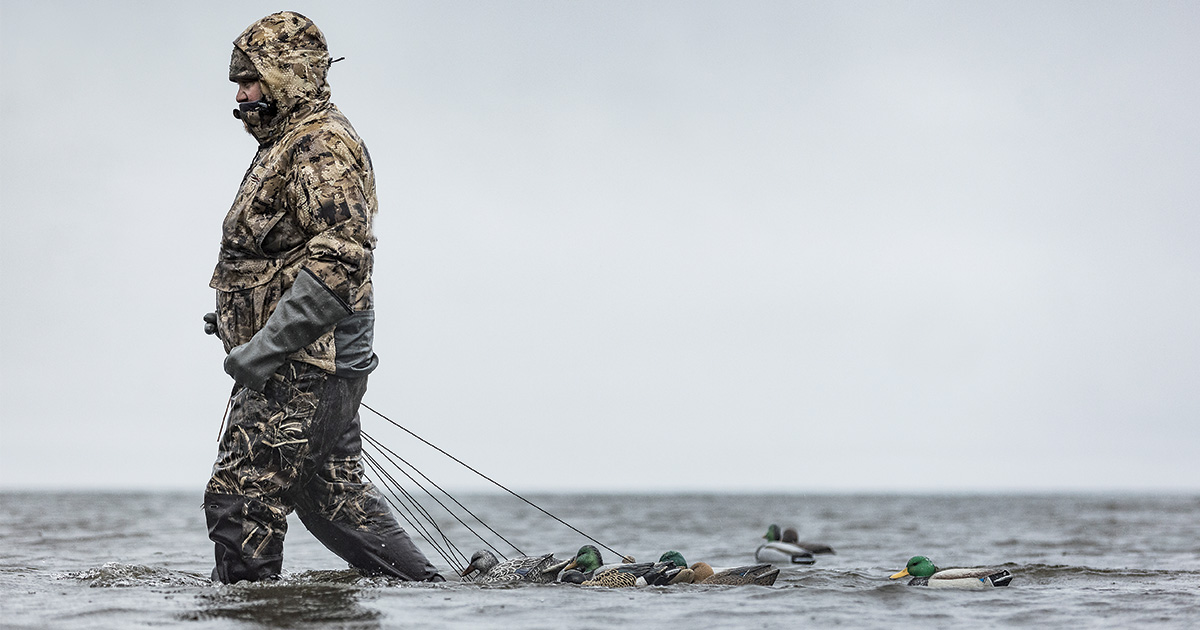Hunting Big Water
Late-season tips for finding success on large lakes and rivers
Late-season tips for finding success on large lakes and rivers


Chasing waterfowl means going where the birds are. As the season progresses, that can involve hunting on lakes, large rivers, and massive reservoirs to target puddle ducks, divers, and geese that concentrate on open water. The following advice from expert waterfowlers focuses on how to hunt safely and effectively when frigid temperatures, ice, and snow push birds to big water.
Troy Poynter spends the final weeks of the waterfowl season targeting mallards, canvasbacks, bluebills, and black ducks from a 24-foot boat on Lake St. Clair and other bodies of water in southwestern Ontario. Making a plan for where to go, Poynter says, begins with knowing when to look. “I like to scout around midmorning, because that’s when the birds tend to be active and on the move, and it is obviously a lot easier to scan the water when the sun is up and you have some light,” says Poynter, who is the owner of St. Clair Guide Service.
While some scouting can be done from shore, Poynter says that the best reconnaissance takes place on the water itself—yet another reason why there is nothing wrong with getting a late start to the day. “There’s no reason to get out on the water in the dark, especially when you’re not familiar with what’s out there,” he says.
Ideally, Poynter is looking for the X while scouting, but refuge boundaries and hunting pressure often mean coming up with a secondary plan when it’s not possible to set up exactly where the birds want to be. This means hunting somewhere along the flight path between where the birds are resting and feeding.
“Finding this line is really important, because if you’re off of it and not underneath where the birds are flying, you’re going to have a much harder time convincing the birds to decoy,” Poynter says. “My recommendation is to be on the water by midmorning, have your binoculars out, find the line where the birds are generally moving, and then make a plan to hunt, maybe as soon as that afternoon. Some of my best hunting can take place between noon and three o’clock.”

When you’re hunting under a flight path and running traffic on birds moving between point A and point B, you need to have a decoy spread that is highly visible. Poynter says that this begins with using as many decoys as you can safely transport in your boat. Using oversized foam-filled decoys, like the Battleship line from Higdon Outdoors, also makes a big difference when it comes to visibility. “Big spreads and big decoys, that’s a good combination,” Poynter says. “When the waves are rolling, the smaller decoys get lost. These bigger, magnum-sized decoys tend to stick out even under those conditions.”
RNT-V’s Shawn Stahl agrees, and he adds that decoys that provide a contrast in color also improve visibility. “I’m a fan of bigger and brighter when it comes to decoys and hunting over big water,” says Stahl, who runs a 20-foot boat with a blind on lakes and rivers each hunting season. “Lots of white, lots of flash, is really important, especially on those cloudy days when the decoys tend to just get washed out.”
Stahl runs longline decoy rigs (multiple decoys connected to a single, heavy line and anchor) and traditional decoy rigs based on the setup, and he is also a big fan of decoy rafts on big water. “The decoy rafts are pretty slick, and they look just like a raft of divers on the water,” he says. “They are also easier for dogs to navigate, because they basically climb right on up and over the mesh raft.”
Even with a large spread of oversized decoys, Stahl says, motion is still an essential element of hunting on a large body of water. “I’m not sure there is a style of hunting where motion isn’t important, but on these big-water hunts, it is key, even more so than calling,” he says. “There needs to be some form of motion in your spread.” This includes splashers, spinners, or any other type of motorized decoy. Stahl says that a goose flag will also work.

While visibility may be good for decoys, it is not for boat blinds. That’s why Poynter and Stahl make the extra effort to stay concealed when hunting. “I have a good base of grass on the blind, and I top it off with green cedar branches, which make the boat look something like an island out in the water,” Poynter says. “The birds don’t seem to mind it at all.”
When brushing out his blind, Poynter extends the cover low enough to meet the surface of the water, eliminating any visible areas of the boat that could reflect light and flare birds. The grassy cover also extends over the top of the shooting holes, which he has designed to be as narrow as possible—this helps keep overhead birds from eyeing the hunters below.
Stahl says that he positions his boat so that the wind is blowing side-to-side rather than directly at his back. “This creates crossing shots for hunters, and it also means that the birds aren’t approaching and finishing straight toward the boat,” he says. “So their attention is on the decoys instead.”
Concealment is also important when hunting along the shoreline of a big body of water, which veteran hunter John Cooper does each fall on the Missouri River’s massive reservoirs in South Dakota. “We’ve had better luck hunting from shore than from a boat, so we have turned to hunting from layout blinds, but there is very little in the way of cover on these shorelines,” Cooper says. “So we try to use cut banks, rocks, driftwood, and anything else we can find to help break up the outlines of the blinds.”
Cooper adds that snow covers on the blinds are a must if the conditions call for them, because snow on the ground makes it extremely hard for ducks and geese to pick out the white blinds along the shore. “All of this, the blinds and covers, just adds more gear to an already long list of things that you have to haul along for one of these late-season big-water hunts, which is why we tend to use at least two boats when hunting with a group of four or five hunters,” he says.

Late-season hunts on big water can be dangerous. Extra boats, cold-weather gear, and a careful eye on the forecast can help you stay safe.
Using more than one boat is a wise move from a safety standpoint, Cooper says. “It pays to have another boat out there in case something happens—engine troubles or whatever. I’ve learned that the hard way.”
All three of these veteran hunters agree that safety on the big water begins by respecting how dangerous conditions can be. In South Dakota, the extremely cold temperatures that occur in December and January should be a top concern. Using layers of quality clothing, including wool caps, glove liners, thick mittens, face masks, and goggles, helps Cooper mitigate the cold, and he says that a change of dry clothes in a waterproof container is a must-have for each hunter in case of an emergency.
The wind poses another danger, says Cooper, who, in addition to decades of hunting experience, has just as much experience patrolling the Missouri River as a federal wildlife officer. This knowledge has taught him that there are days when you have to be willing to say, “Nope, I’m not going.”
“This could mean being at the boat ramp, ready to launch, and the wind forecast changes,” Cooper says, “and now those wind speeds are going to gradually build throughout the day. I might be able to navigate my way out, but coming back is not going to be good. I feel confident in my gear and my boat, and I have the right gear, but there still comes a point where it is simply too dangerous to head out.”
Stahl keeps a close eye on the forecast, and he stresses that it is important to look at a marine forecast, if possible, because conditions a mile or two off the shore of a big body of water may be different from what is forecast to occur two or three miles inland. “I also keep an eye on water levels when I’m hunting ariver system. I’ll actually mark the height of the water first thing in the morning on a pole, and then I’m watching that level, checking it every 30 minutes or so. If that level starts to fall, I know that I might have to make a decision pretty quickly about sticking things out,” Stahl says.
Poynter recommends a pre-hunt check of the boat for safety equipment, life vests (which should be worn to and from the launch), boat plug, and first-aid kit. He also says that hunters should be familiar with GPS and know how to read a map, including channel markers. Cell phones with “share my location” capabilities are great, but hunters should always let someone know where they plan to be and when they plan to return.
Late-season hunts on big water can be challenging and even dangerous, but Cooper believes hunters should consider giving it a try. “If you have the right gear, have a plan, and respect the water, you can have some of the best hunts of your life out there,” he says.
Ducks Unlimited uses cookies to enhance your browsing experience, optimize site functionality, analyze traffic, and deliver personalized advertising through third parties. By continuing to use this site, you agree to our use of cookies. View Privacy Policy